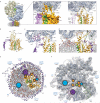Cryo-EM structure of the ribosome-SecYE complex in the membrane environment
- PMID: 21499241
- PMCID: PMC3412285
- DOI: 10.1038/nsmb.2026
Cryo-EM structure of the ribosome-SecYE complex in the membrane environment
Abstract
The ubiquitous SecY-Sec61 complex translocates nascent secretory proteins across cellular membranes and integrates membrane proteins into lipid bilayers. Several structures of mostly detergent-solubilized Sec complexes have been reported. Here we present a single-particle cryo-EM structure of the SecYEG complex in a membrane environment, bound to a translating ribosome, at subnanometer resolution. Using the SecYEG complex reconstituted in a so-called Nanodisc, we could trace the nascent polypeptide chain from the peptidyltransferase center into the membrane. The reconstruction allowed for the identification of ribosome-lipid interactions. The rRNA helix 59 (H59) directly contacts the lipid surface and appears to modulate the membrane in immediate vicinity to the proposed lateral gate of the protein-conducting channel (PCC). On the basis of our map and molecular dynamics simulations, we present a model of a signal anchor-gated PCC in the membrane.
Figures





Similar articles
-
Structure of the E. coli protein-conducting channel bound to a translating ribosome.Nature. 2005 Nov 17;438(7066):318-24. doi: 10.1038/nature04133. Nature. 2005. PMID: 16292303 Free PMC article.
-
Structures of the Sec61 complex engaged in nascent peptide translocation or membrane insertion.Nature. 2014 Feb 6;506(7486):107-10. doi: 10.1038/nature12950. Nature. 2014. PMID: 24499919
-
Structure of the SecY channel during initiation of protein translocation.Nature. 2014 Feb 6;506(7486):102-6. doi: 10.1038/nature12720. Epub 2013 Oct 23. Nature. 2014. PMID: 24153188 Free PMC article.
-
Translocation of proteins through the Sec61 and SecYEG channels.Curr Opin Cell Biol. 2009 Aug;21(4):501-7. doi: 10.1016/j.ceb.2009.04.010. Epub 2009 May 18. Curr Opin Cell Biol. 2009. PMID: 19450960 Free PMC article. Review.
-
Protein traffic in bacteria: multiple routes from the ribosome to and across the membrane.Prog Nucleic Acid Res Mol Biol. 2001;66:107-57. doi: 10.1016/s0079-6603(00)66028-2. Prog Nucleic Acid Res Mol Biol. 2001. PMID: 11051763 Review.
Cited by
-
Structure and dynamics of a nanodisc by integrating NMR, SAXS and SANS experiments with molecular dynamics simulations.Elife. 2020 Jul 30;9:e56518. doi: 10.7554/eLife.56518. Elife. 2020. PMID: 32729831 Free PMC article.
-
mRNA targeting eliminates the need for the signal recognition particle during membrane protein insertion in bacteria.Cell Rep. 2023 Mar 28;42(3):112140. doi: 10.1016/j.celrep.2023.112140. Epub 2023 Feb 25. Cell Rep. 2023. PMID: 36842086 Free PMC article.
-
Co-translational insertion and topogenesis of bacterial membrane proteins monitored in real time.EMBO J. 2020 Aug 3;39(15):e104054. doi: 10.15252/embj.2019104054. Epub 2020 Apr 20. EMBO J. 2020. PMID: 32311161 Free PMC article.
-
Molecular basis for erythromycin-dependent ribosome stalling during translation of the ErmBL leader peptide.Nat Commun. 2014 Mar 24;5:3501. doi: 10.1038/ncomms4501. Nat Commun. 2014. PMID: 24662426 Free PMC article.
-
GPU-accelerated analysis and visualization of large structures solved by molecular dynamics flexible fitting.Faraday Discuss. 2014;169:265-83. doi: 10.1039/c4fd00005f. Epub 2014 Jun 30. Faraday Discuss. 2014. PMID: 25340325 Free PMC article.
References
-
- Rapoport TA. Protein translocation across the eukaryotic endoplasmic reticulum and bacterial plasma membranes. Nature. 2007;450(7170):663–669. - PubMed
-
- Halic M, Beckmann R. The signal recognition particle and its interactions during protein targeting. Curr Opin Struct Biol. 2005;15(1):116–125. - PubMed
-
- Van den Berg B, et al. X–ray structure of a protein–conducting channel. Nature. 2004;427(6969):36–44. Epub 2003 Dec 2003. - PubMed
Publication types
MeSH terms
Substances
Associated data
- Actions
- Actions
Grants and funding
LinkOut - more resources
Full Text Sources
Other Literature Sources
Molecular Biology Databases

